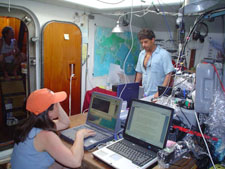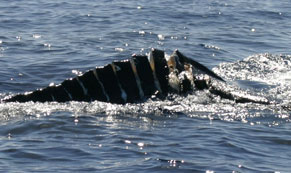Working Towards Conservation and Management
 Findings from Cetos projects have been utilized for conservation and for improved management of wildlife and habitat. Some examples of useful data we have collected for conservation work include:
Findings from Cetos projects have been utilized for conservation and for improved management of wildlife and habitat. Some examples of useful data we have collected for conservation work include:
- Various projects for Northwest Fisheries Science Center (Seattle, WA) including analyzing killer whale sounds, building hydrophone arrays, and GIS mapping of satellite derived data in Northwest waters from Washington to Monterey Bay, CA;
- Pelagic (deep water) surveys and studies combining traditional visual-based observations with newer, non-invasive, passive acoustic tracking;
- Survey data using combined techniques yielding much higher “encounter rates” (of critters) than typical from using either method alone;
- Survey findings yielding new observations of several species (including some rarely documented in Hawaiian waters); and
- Survey data resulting in first ever Photo-ID data for the critically endangered Vaquita.
Cetos study findings and knowledge have been applied to conservation and management activities. Some examples include:
- Development of Federal Agency Marine Species Awareness Training DVD for shipboard observer training. We obtained video of marine mammal sightings for use in learning how to sight animals in good and bad weather conditions. This is a one-of-its-kind online identification training course used by several Federal agencies (USCG, US Navy, NOAA, etc.).
- Our research from in-water sound/behavior studies of humpbacks has proven crucial for management of this endangered species in Hawaii and elsewhere;
- Reporting severely human-caused injured animals to proper authorities in a timely manner, in hopes of saving the animals (see photo below).

Information on the ecology, behavior, distribution, and habitat requirements for many species is presently lacking. This information is critical, if effective and informed decisions are to be made about management and conservation of these important living marine resources. Impacts to marine wildlife from increases in man-made noise and vessels and other human presence in natural habitats is a growing problem. Our work contributes locally in study areas as well as globally for species that occur in many areas. We design our work to contribute to the goals of the Hawaiian Islands Humpback Whale National Marine Sanctuary, the Marine Mammal Protection Act (MMPA), Endangered Species Act (ESA), and the National Environmental Policy Act. Assessing impacts from human disturbance is increasingly important and is a major goal of virtually every Large Whale Final Recovery Plan.
We work hard to distribute the most up-to-date information as quickly as we can to management organizations.

